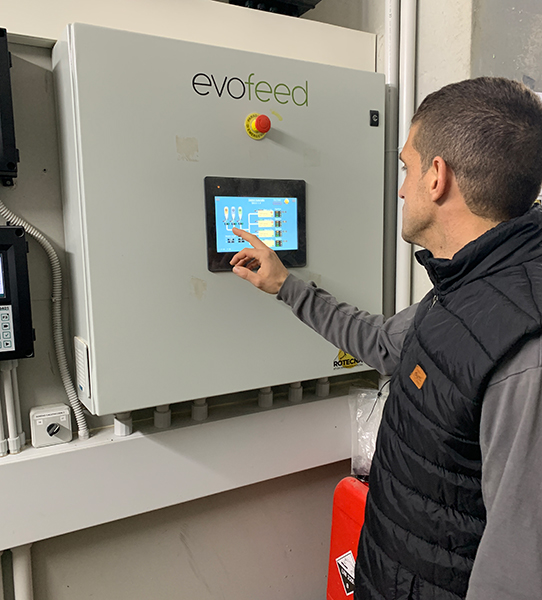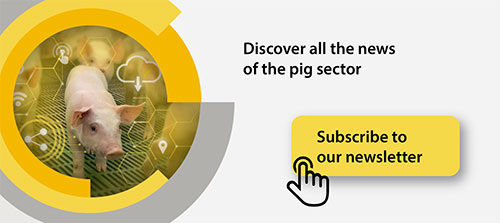Blog
Blog

Automation in pig farms for efficient production
23rd October 2025 - News
Automation is transforming the way work is done on pig farms. More and more farms are incorporating automated systems that adjust feeding, control the environment, or manage health without relying on constant manual labor. These tools not only save time but also enable data-driven decision-making, reduce resource waste such as feed, and improve animal welfare. In this way, technology becomes an ally for producing more and better, with less effort and greater control.
Automated feeding
Feeding is one of the areas where automation has achieved the highest level of development. Automatically controlling the amount and type of feed each animal receives improves feed conversion, reduces waste, and promotes batch uniformity.
In modern farms, phase-feeding systems make it possible to adapt the diet according to age, weight, or production stage. This feeding precision optimizes resource use and improves animal welfare by providing nutrition that matches each pig’s real needs.
Practical examples of feeding automation
Different technologies on the market make it possible to apply this precision approach. In the case of Rotecna, three solutions stand out:
- Evofeed, an automatic dispenser designed to manage the quantity of feed supplied and perform transitions between feeding phases without the need for valves or additional weighing. This system simplifies management and ensures stable dosing, reducing variability between batches.
- Dositronic M, designed for maternity rooms, allows individual feeding of each lactating sow based on her actual intake. The system adjusts the daily ration and records which animals have eaten, enabling quick detection of health or appetite issues.
- Dositronic G, intended for gestating sows, provides precise management of feed intake and body condition. Thanks to individual identification, the farmer can check how many sows have eaten and what adjustments to make in the feeding curve, without relying on manual observation.
In addition, automated feeding helps improve production efficiency and reduce piglet mortality by controlling nutrition from birth, adjusting the sow’s milk production, and managing the transition of piglets to solid feed.

Multi-phase systems allow feeding to be adapted to the weight and age of the animals. Photo: Rotecna.
Automatic drinkers and environmental control
Water and environment are decisive factors in productive performance and animal welfare within a pig farm. Automation makes it possible to manage them precisely, ensuring animal comfort, reducing resource waste, and preventing health problems caused by heat stress or poor air quality.
Automatic drinkers
Automatic drinking systems with regulated flow and leak sensors ensure a constant and controlled water supply. By detecting losses or abnormal consumption, they prevent waste and help maintain water quality. In addition, their integration with control software makes it possible to record daily data and adjust flow according to the animal’s age or category.
Smart environmental control
Maintaining stable environmental conditions is essential for the health, comfort, and welfare of pigs. Temperature, humidity, ventilation, and air quality directly affect their behavior, feed intake, and productive performance.
Systems such as Sensoritronic integrate temperature, humidity, and gas sensors (such as ammonia or CO₂). As a result, a stable and comfortable environment is achieved, reducing animal stress and promoting growth. The farmer can monitor all parameters from a screen or mobile device and receive alerts in case of deviations, ensuring efficient, sustainable management focused on animal welfare.

Maintaining stable environmental conditions is essential. Photo: Rotecna.
Cleaning, disinfection, and biosecurity
Cleaning and disinfection are essential tasks for maintaining a high level of biosecurity on pig farms. Automating these processes improves hygiene, reduces workload, and minimizes health risks.
Washing robots and automatic disinfection systems
More and more farms are adopting programmable robots that move through corridors and rooms applying high-pressure water after emptying, ensuring uniform cleaning without relying on manual labor. These machines can be programmed by zones or times, which optimizes water use and improves biosecurity.
Complementing this system are automatic disinfection technologies, such as scheduled fogging or ultraviolet (UV) light disinfection. Both options help keep rooms pathogen-free even between batches, minimizing the risk of disease transmission. In practice, the result is a cleaner farm, with a lower microbial load and a safer environment for both animals and staff.
Automating to produce better
Automation in pig farms is not a passing trend but a practical response to today’s industry challenges: high costs, the need for efficiency, animal welfare, sustainability, and environmental demands.
Its implementation can be done progressively, starting with high-impact processes, such as feeding or environmental control, and later expanding to other areas. The key is to adopt connected systems, easy to manage and capable of generating useful data for decision-making.
Automation does not mean complicating management, but rather producing more efficiently, sustainably, and precisely, maintaining total control over every aspect of the farm and ensuring a more responsible future for pig production.








